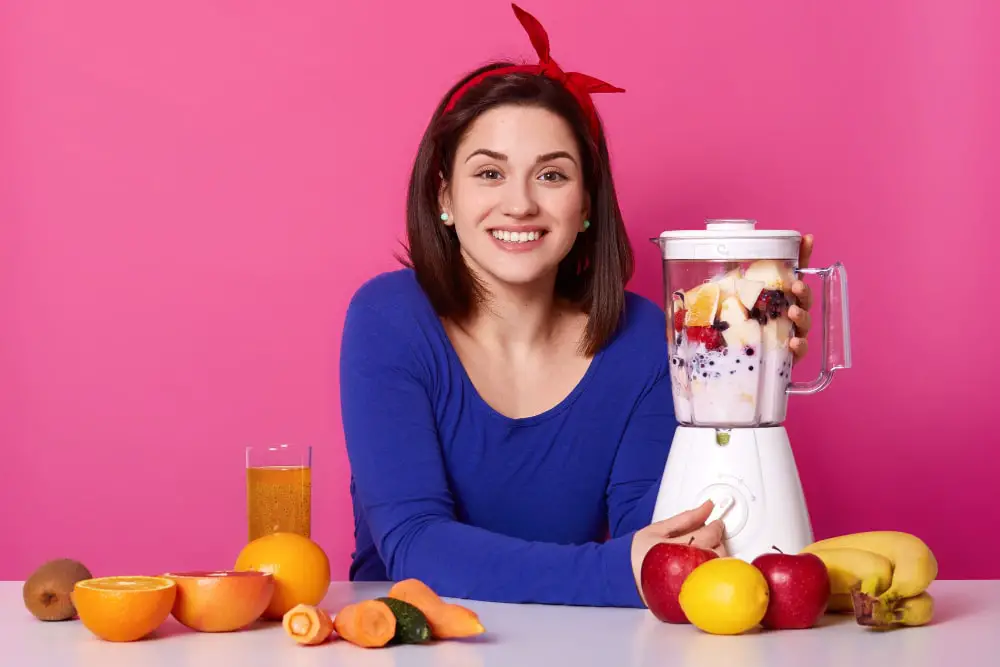This post contains affiliate links. When you buy through our links, we may earn a commission.
Are you on an excellent quality Food Processor or an Immersion blender?
But you might be in a state of confusion: Which one will suit your needs better?
Well, to clear your doubt, both the appliances are different from each other. However, in some cases, a food processor can fulfill your blending needs too.
A food processor is a lot more powerful than an immersion blender. It can serve blending activities but lacks consistency and textures.
So in this blog will guide you with all possibilities and working of a food processor with an immersion blender.
Stay tuned!
Food Processor
A food processor is a household gadget that is being used to support routine activities of food processing. While certain traditional machines are often described as “food processors,” the term now almost exclusively relates to an electric-motor-driven unit.

In specific ways, food processors are close to blenders. However, in contrast to a blender, which needs a certain volume of moisture and the blade to mix the material correctly, a food processor usually involves almost no liquid throughout the operation.
As a result, food processors are being used to mix, cut, chop, and slice foods, making meals prepared faster.
Immersion Blender
Immersion blenders use no bowl to liquefy and puree ingredients. Instead, these electrified portable gadgets can be carried all around the kitchen and immersed in storage containers or stirring vessels.
For example, the efficient blades at the bottom of the blender help you to puree salad dressings or seasonings straight in the bowl, without the requirement to switch food items.
Food Processor vs Immersion Blender – Similarities
An immersion blender and a food processor seem to have several striking similarities when you use it for the first time.
Most variants of both machines do have sharp blades connected with a powerful motor and a storage bowl. The blades rotate at high speed to cut food items inside the container. You could also use these hand in hand with such functions, such as pureeing or ice grinding.
Blenders and food processors mostly look almost similar in mid-level, whereas most processors within that size lack the iconic feeding canopy.
Furthermore, several of the same companies that manufacture processors often manufacture immersion blenders. With such a similar style and now so identical branding, the difference becomes even more confusing.
Food Processor vs Immersion Blender – Differences
There are numerous factors that anyone would pair up between a food processor and an immersion blender. But still, both are different from each other in various areas.
First is that food processor designs are emerging. However, traditional units continue to dominate the industry.
Without wasting time in comparing their shape and size, let’s start comparing their performance and productivity.
Immersion Blender & Food Processor Comparison
| Properties/Factors | Immersion Blender | Food Processor |
|---|---|---|
| Placement of blades | One blade for all types of activities. | Multiple cuttings blades with easily detachable features. |
| Types of blades | No special blades available | Comes with chopping blondes, slicing blades, shredding, and grating disc |
| Sharpness of blades | The blade is not sharp, which makes it not perfect for chopping | Chopping S blades are exceptionally sharp for fast food preparation |
| Crushing performance | Blades are best for crushing food items | Consumes more time for crushing food items. |
| Food and Recipes | Best for smooth liquid mixtures like smoothies, soups, and dips | Best for grinding nuts and coffee beans. Perfect for serving hard food items |
| Vortex mechanism | Uses a vortex mechanism to crush food items. Drag down the ingredients onto the blades | No vortex technology uses a high-speed and powerful motor to grind all types of food items. |
| Versatility | Not a versatile appliance | Offers a variety of food processing, makes it more versatile. |
Food Processor vs Immersion Blender – Their Specialties
When to Use a Food Processor? Here are some best uses and specialties a Food Processor must-have.
For Kneading
Though mixers are ideal for producing pastry batters, food processor blades produce the firm consistency necessary for bakery products, pizza doughs, and cookies. For example, if you have a powerful food processor from a reputable manufacturer, you’ll choose it after analyzing the volume of the container.
However, the food processor can adequately knead the dough for about everything you wish to eat.
Would you like to produce your bread dough? A food processor can do it as well, with the added advantage of significantly reducing preparation time.
For Shredding, Grating, Slicing, and Chopping
A food processor is ideal for tasks requiring an enormous amount of Shredding, Grating, Slicing, and Chopping. Consider
- Cauliflower risotto (in which cauliflower serves as the “rice” component)
- Coleslaw (made with precisely sliced carrots, cabbage, as well as onions)
- Breading (made with elegantly minced peanuts and seed pods or even refried beans.
Some blenders can also serve certain chopping activities. However, the consistency is best with a Food Processor.
Slicing, on the other hand, is one that the blender cannot do. Therefore, food processors provide customizable slicing discs that make it possible to slice & grate foods uniformly.
Your sole responsibility is to ensure that the proper attachment seems to be in order. For example, you can cut potatoes into fries, cucumbers, and yams into slices for snacks, and onions into rings with all these discs attachments. It’s simple, convenient, and powerful.
For Mixing
When you’re about to mash or blend stuff but don’t want the final product to be substantial and smooth, a food processor comes in handy. Pasta sauce, gummy sauce, organic nutrition drinks, protein bars, organic oatmeal cookies, rice Krispies, and other similar items fall under this category.
The main purpose of having a food processor was to make raw desserts. For example, in a blender, you can’t blend almonds and dates into energy balls and cookies. However, a food processor is powerful enough to grind all types of food ingredients with ease.
When to use an Immersion Blender? Here are some best uses and specialties an Immersion Blender must-have.
For Crushing
Do you love to have shaved ice, also known as snowballs, or enjoy having snow cones in your childhood days? Normal ice cream bars are common but have different-sized snow bits of ice that stick together to offer a unique punch of taste and fun.
Snow cones require a container for offering it a shape. So do you think it is easy to crush ice blocks with a regular blender for smoothies? Well, it is not possible at all unless you have a powerful blender like Vitamix. These blenders can crush ice cubes within seconds.
Shaving and grinding ice is a complicated process for standard blenders. Low-wattage blenders may chop ice but not blend it. Ice can indeed be scraped but not crushed with low-quality blender blades. So, if you do not want your normal blender’s life to be cut short, think carefully of the tasks you allocate to it.
For Blending
Suppose you have a high-speed advanced immersion blender. Step into something such as a smoothie bar or perhaps a coffee house. You can almost certainly see a powerful blender producing various beverages for years without losing its productivity. This system can crush almost everything you throw at it.
All traditional blending activities, such as protein shakes, vegetable beverages, sauces, desserts, seasonings, and baby foods, are accomplished by an immersion blender. It’s also excellent for dense mixes like ice desserts, icy treats, nut milk, dips, and sauces. The configuration of the strong motor, the propagation force, and the tamper contribute to its performance.
You may use the scooper to drive food items down, avoid interrupting the machine, unlocking the door, and scraping down the edges. These characteristics are just what distinguishes immersion blenders from other blenders on the marketplace.
For Grinding
Grinding down the nuts, seeds, grains, and legumes is not an easy task for a regular immersion blender. However, if your blender ships with a powerful motor, it can accomplish the task easily.
Grinding stuff using an immersion blender is possible; however, it consumes a lot more time and keeps you busy for hours for a consistent texture.
In general, immersion blenders are not meant for grinding stuff like hard grains, legumes due to their dull blades. In addition, wear and tear are prevalent with immersion blenders if you practice regular grinding.
Should You Buy an immersion blender or a Food Processor?
If you are preparing guild-based guild-based soups, drinks, and sauces, an immersion blender is best for you. However, if your needs are like slicing or grinding foodstuffs, including batter preparation, then a food processor should be your first preference.
Work containers in food processors are deep and smooth on the bottom. They can puree fluids but are difficult to pour over. They can handle hard, solid food items, which a blender can’t.
As the blender blades spin, they generate a vacuum that accumulates the liquid in the machine, causing everything to be pummeled thoroughly. When there is insufficient water in the container, the vortex movement cannot develop; therefore, there will be no creamy puree.
Food processors are best for preparing ingredients for recipes.
Food processors are ideal for those who need help with meal preparation. Because they have grating and grinding disks, these can be used for much more than pureeing. They’re great for grinding pork, shredded cabbage, and chopping tomatoes.
Food processors only with simple steel blades can chop food items like broccoli, onions, tomatoes, or beans reasonably well, as long as the accuracy of cutting is not essential. However, a food processor is an excellent option if you need to perform various slicing and dicing preparation.
Do you want to puree?
Food processors are ideal for making creamy purees, such as peanut butter, or clumpy sauces, such as salsa. A soup (such as baked potato soup) can be pureed in a food processor. However, the soupy cooked fluid is prone to leaking onto the surface in the first few seconds of pureeing.
Quite a pain! Furthermore, blenders do often produce smoother purees with their low-powered blades. On the other hand, the blade crushes liquidly purees, including sauces and milkshakes, even faster than food processors. The vortex force allows the blender to excel in pureeing.
Final Verdicts
Finally, choosing a Food processor over an immersion blender or vice versa is depends on your fooding needs. Of course, there are differences between them; still, they coincide in multiple zones.
If you can compromise with power and versatility, then an immersion blender is for you. Or else you can manage with an average consistent smoothie but can’t miss delicious cake batter preparing the simple go with Food processors.
Think wise and analyze your food habits and pick the best!
